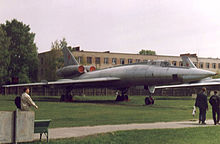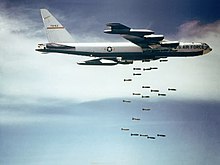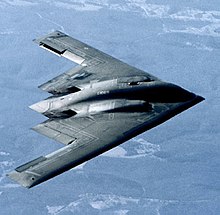bomber
A bomber, or bomber plane , is a fighter plane that is used to attack ground targets with aerial bombs and air-to-surface missiles . Airplanes, which are also used to combat aircraft, usually fall under the term fighter-bomber .
History of the bomber
The beginnings
First came bombers in World War I for use. The first bomb attack took place in the Italo-Turkish War on November 1, 1911, when Giulio Gavotti dropped three 2 kg bombs by hand on a Turkish military camp from an Etrich Taube .
The Bulgarian pilot Simeon Petrow developed the first aerial bomb with tail fin and detonator in 1912 in the First Balkan War . This bomb, weighing around 6 kg, was used for the first time in an attack on the Turkish train station near Karaağaç . The plans for this bomb were later sold to Germany. This aerial bomb, code-named "Chataldscha" ("Чаталджа"), was mass- produced until the end of the First World War .
Initially, however, only military airships were able to carry a large load of bombs over long distances. Many nations use such airships to attack military targets, but also industrial plants or city centers. Airships could then fly higher and further than any aircraft and thus operate out of the range of anti-aircraft weapons. However, this was to change in the course of the First World War. In June 1915, an English fighter plane succeeded for the first time in shooting down a German airship.
From 1917, large aircraft and later giant aircraft were built in Germany as strategic bombers . These were four-engine biplanes with a wingspan of over 40 meters. Some bombers of the First World War already had a release mechanism with which the bombs attached to the lower wing or fuselage were released.
Bomb attacks were carried out day and night and were directed against large cities and industrial plants, but also against enemy airports and other ground targets. After the end of the First World War, many bombers were converted for use in commercial aviation.
Bombers used in World War I:
- Schütte-Lanz (airship)
- Zeppelin (airship)
- AEG G.IV
- Friedrichshafen G.III
- Gotha G.III
- Gotha G.IV
- Gotha GV
- Zeppelin (Staaken) R.VI
- Caproni about 3
- Caproni ca.42
- Airco DH.4
- Airco DH.9
- Handley Page O / 400
- Sikorsky Ilya Muromets
- Voisin III
Second World War
In the run-up to the Second World War , the Spanish Civil War in 1937 saw the first tactical point bombing. Up to this point, attempts were only made to completely destroy an area with as much explosive force as possible or the bombs were dropped “blindly”. These tactics, used primarily by the United Kingdom against insurrections in its colonies, were not to change until the new German Air Force was established in 1935.
In the German Air Force , which existed from 1935 to 1945 , bombers were usually referred to as combat aircraft . Other terms such as Atlantic bomber, Uralbomber or high-speed bomber are more likely to be assigned to propaganda . The Luftwaffe introduced the military concept of combined arms in 1935 . This means, among other things, that the army and air force are closely linked by air force liaison officers traveling with the army units on the ground . This concept requires precise planning of the combat against military targets. For this reason, the military leadership only allowed twin-engine tactical bombers, e.g. B. build the Ju 88 . From 1940 to 1941, German bombers attacked the southern parts of the United Kingdom in preparation for an invasion in the so-called Battle of Britain . Ultimately, however, it was primarily the limited range of the escort fighters and the high bomber losses that led to the attacks being largely stopped in 1941.
In 1940 the British began bombing Germany for their part. Since up to 50% of the aircraft were shot down in the first attacks, the British specialized in the less loss-making night bombings. Because of the lower accuracy of hits in night bombings , they could only fly area bombs on large area targets such as large cities (see also air strikes against cities ).
The American Air Force began daytime bombing of point targets such as factories and transport facilities after the United States entered World War II in 1943. Through improved formation tactics , especially through escorts with newly developed long-range escorts (from 1944) and through the advancing front from mid-1944, it was possible for the bombers to penetrate further and further into the German heartland.
One of the bombers used by the British was the Avro Lancaster . The Lancaster was the backbone of the RAF Bomber Command's bombing raids against Germany. It set new standards in bomb load capacity and transport height. It usually carried 6,350 kg at 7,300 meters, but it could also drop a single 9,980 kg bomb on targets such as viaducts or submarine bunkers . The Lancaster had a range of over 4000 km, which hardly any other bomber could achieve at the time.
The bombing of Japan by US bombers began in late 1944. The newly developed B-29 bomber was also used, a machine with a very long range.
During the Second World War , the beginnings of cruise missiles and rockets developed as bomb carriers, which in the further course of military history took over part of the tasks of bombers, but did not completely replace them.
Bombers used in World War II (selection):
- Arado Ar 234
- Armstrong Whitworth Whitley
- Avro Lancaster
- Avro Manchester
- Boeing B-17
- Boeing B-29
- Bristol Blenheim
- Bristol Beaufort
- Consolidated B-24
- CRDA Cant Z.1007
- de Havilland DH.98 Mosquito
- Handley Page Halifax
- Heinkel He 111
- Heinkel He 177
- Ilyushin Il-4
- Junkers Ju 87
- Junkers Ju 88
- Martin B-26
- Mitsubishi G4M
- Nakajima Ki-49
- North American B-25
- Petlyakov Pe-8
- Piaggio P. 108
- Savoia Marchetti SM.79
- Short Stirling
- Tupolev Tu-2
- Vickers Wellington
1950s to today

The US Strategic Air Command had up to 2,600 bombers operational during the Cold War to attack targets more than 6,400 km away with conventional and nuclear bombs. The British Royal Air Force maintained up to 280 strategic bombers, the so-called V-Force , for this purpose .
Cold War and Today Bombers:
- Avro Vulcan
- Boeing B-47 Stratojet
- Boeing B-52 Stratofortress
- Convair B-58 Hustler
- Convair B-36 Peacemaker
- Dassault Mirage IV
- General Dynamics FB-111
- Handley Page Victor
- Myasishchev M-4
- Northrop B-2
- Rockwell B-1
- Tupolev Tu-22M
- Tupolev Tu-95
- Tupolev Tu-16
- Tupolev Tu-160
- Tupolev Tu-22
- Vickers Valiant
Development of technology
Bomb attacks were initially only possible when visibility was good . During the Second World War , beacon methods, radio navigation and radar made attacks possible even at night and when the cloud cover was closed. Inertial navigation systems were later introduced, which could determine the position of a bomber with great accuracy. Nowadays the target is often located with GPS , so that bombing attacks are possible even when it is cloudy and at night.
Used weapons
One of the first targets of bombers is usually the enemy air defense . Some bombers are also of gunners served machine guns or board cannons equipped. Nevertheless, bombers are easily vulnerable to enemy fighters and are therefore often escorted by escort fighters .
Conventional
The bombs are dropped by the crew over the target area; These can be unguided dumb bombs or more precise, such as laser-controlled, smart bombs (German, intelligent bombs). So-called bomb carpets and cluster bombs , which disintegrate on the ground into many warheads ( bomblets ), some of which do not detonate immediately and endanger civilians, are controversial . Retrofit kits are increasingly being used for free-falling bombs, which direct them to individually programmed ( GPS ) or laser-marked targets ( JDAM ).
Free falling nuclear weapons
In the early phase of the Cold War, the use of strategic bombers was a central component of possible nuclear warfare. With the introduction and further development of ICBMs as a delivery system, the strategic bomber fleet became increasingly obsolete. Still, practically all American bombers are designed to carry nuclear weapons to their target. With many modern nuclear bombs, the force of the nuclear explosion can be adjusted from the lower kiloton range for tactical use in battlefields to the megaton range for attacks on cities or to combat so-called "hardened targets" (e.g. underground command bunkers, rocket silos).
Short-range missiles
The populated with nuclear warhead AGM-69 SRAM ( S hort R is A ttack M issile = short-range missile attack) was such as ground-to-air missile launch sites designed for smaller targets. It was particularly suitable for this because its inertial steering system could not be disturbed by the ECM . The SRAM is the type of weapon that could be used to “limit” a war because it is aimed at military targets. It would eliminate any kind of fixed defenses in a given area and give the enemy no chance to retaliate, e.g. B. against the B-1B that transports the SRAM. A B-1B can take two dozen SRAM on board. Each is 4.30 m long, weighs 1000 kg and hits its target with Mach 2.5. When fired at high altitude, it can fly 200 km, from low altitude 35 miles.
Airborne cruise missiles
Since cruise missiles (or rockets ) fired from the air by bombers can reach distant targets, there is little risk for the crew.
The cruise missiles (Air Launched Cruise Missile / ALCM) currently used exclusively for the B-52 by the US Air Force are produced by Boeing, such as the Boeing AGM-86 Cruise Missile . They have their own turbofan drive and rudimentary controls, as well as electronic devices that are preset with target information. When they are fired, they automatically (also with the help of GPS) follow their commands to the target.
Classification
Special cases of bombers are
- Strategic bombers , e.g. B. the American Boeing B-52
- Fighter- bomber , a mixture of fighter and bomber, for example the European Panavia Tornado (also called tactical bomber)
- Stealth bombers , e.g. B. the American Northrop B-2
In the Second World War one distinguished:
- Light bombers with mostly one engine, e.g. B. the Fairey Battle
- Medium bombers with mostly two engines, e.g. B. the Junkers Ju 88
- Heavy bombers (Viermots) with mostly four engines, e.g. B. the Boeing B-29 Superfortress
- Dive into action aircraft , for example the Junkers Ju 87 Stuka
- Horizontal bomber , for example the Heinkel He 111
- Torpedo bombers , e.g. B. the Fairey Swordfish
- Fast bombers , e.g. B. the De Havilland DH98 Mosquito
- Attack aircraft - ground attack aircraft that operated in the front region near z. B. the Henschel Hs 123 or the Il-2 Sturmowik
- Fighter-bombers (Jabos) , e.g. B. the Republic P-47
(Until 1945 "fighter aircraft" was used as a synonym for bomber.)
See also
- Raisin Bomber
- Air war
- Fighter plane
- Tanker aircraft
- Reconnaissance plane
- List of aircraft types
- Single-jet aircraft (with classification according to area of application, dimensions and production)
- Twin-engine aircraft (with classification according to area of application, dimensions and production)
- Three-jet aircraft (with classification according to area of application, dimensions and production)
- Four-engine aircraft (with classification according to area of application, dimensions and production)
- Six-engine aircraft (with classification according to area of application, dimensions and production)
- Eight-engine aircraft (with classification according to area of application, dimensions and production)
literature
- Chris Chant: Bomber . An illustrated history of the bombers from 1914 to the present day. Tosa, Vienna 2001, ISBN 978-3-85492-326-8 .
- Wilfried Copenhagen : Soviet bomb planes . Transpress , Berlin 1989, ISBN 3-344-00391-7 .
Trivia
The record scorer in the Bundesliga with 365 goals, Gerd Müller , is called the “nation's bomber” .
Web links
Individual evidence
- ↑ 20 minutes from 13./14. May 2011: The very first bomb fell on Libya
- ^ Bulgarian Aviation in the Great War (English), accessed on April 5, 2018













